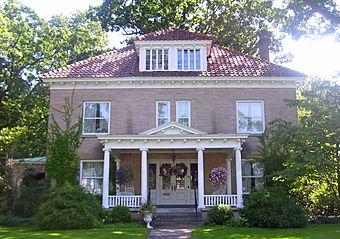Irving Langmuir House facts for kids
|
Irving Langmuir House
|
|
|
U.S. Historic district
Contributing property |
|

Front elevation, 2008
|
|
| Location | 1176 Stratford Road, Schenectady, New York |
|---|---|
| Area | less than one acre |
| Built | ca. 1900 |
| Architectural style | Colonial Revival |
| Part of | General Electric Realty Plot (ID80002763) |
| NRHP reference No. | 76001275 |
Quick facts for kids Significant dates |
|
| Added to NRHP | January 7, 1976 |
| Designated NHL | January 7, 1976 |
| Designated CP | November 18, 1980 |
The Irving Langmuir House is a special old house located at 1176 Stratford Road in Schenectady, New York. It was built around 1900. This house was once the home of a very famous scientist named Irving Langmuir. He was a physicist and a chemist. Mr. Langmuir won the 1932 Nobel Prize in Chemistry for his amazing work. He did much of his important research while working at General Electric. Because of its history, this house was named a National Historic Landmark in 1976.
About the Langmuir House
The Irving Langmuir House is found in a neighborhood near Union College. This area is called the General Electric Realty Plot. It is a special historic district. This means the whole area has important old buildings. The neighborhood has many large homes built in the late 1800s and early 1900s.
The house itself is on the east side of Stratford Road. It is a two-and-a-half-story building. It has a style called Colonial Revival. The roof is sloped and covered with terra cotta tiles. It also has two windows sticking out from the roof. A porch with columns covers the main front door. Inside, the house has a simple layout with a main hallway in the middle.
Who Was Irving Langmuir?
The house was likely built around the year 1900. Irving Langmuir moved into this house in 1919. He lived there until he passed away in 1957. His family still owned the house when it became a landmark.
Langmuir started working at GE's research lab in Schenectady in 1909. He did important basic research there. His work covered many areas of physics and chemistry. He retired in 1950. Langmuir received many awards for his discoveries. The most famous was the 1932 Nobel Prize in Chemistry. He won it for his work on surface chemistry. This field studies what happens at the surface of materials.




